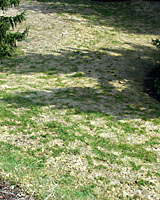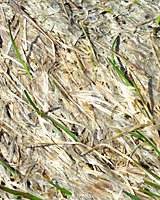Terry L. Ettinger Horticulture Consulting Services
Meeting The Needs Of Today With A Vision For The Future
Question of the Week
Snow Mold Control
 Q. During the past month we've received calls and flyers from various lawn services encouraging us to purchase a
special "snow mold" treatment this spring. They say that because of our long, cold winter, this disease may cause serious damage
to our lawn. Do you think this is a good idea?
Q. During the past month we've received calls and flyers from various lawn services encouraging us to purchase a
special "snow mold" treatment this spring. They say that because of our long, cold winter, this disease may cause serious damage
to our lawn. Do you think this is a good idea?
A. Both pink (Fusarium patch) and gray (Typhula blight) snow mold infect grass blades during periods of cool (35F-40F), wet weather from late fall through spring. Therefore, it's not bitterly cold winter temperatures that provide ideal conditions for these fungi, but rather cold, damp conditions that are so common during periodic thaws throughout the winter - and especially in March and even April.
 The good news is that only grass blades are infected - not the crowns of grass plants that are
located right at or just below the soil surface. Therefore, as "low-tech" as it may seem, simply breaking apart
the matted crust of dead leaf blades, at left, with gentle, straight up-and-down strokes of a leaf rake - not vigorous
horizontal strokes as if raking leaves - is the single best way to deal with snow mold.
The good news is that only grass blades are infected - not the crowns of grass plants that are
located right at or just below the soil surface. Therefore, as "low-tech" as it may seem, simply breaking apart
the matted crust of dead leaf blades, at left, with gentle, straight up-and-down strokes of a leaf rake - not vigorous
horizontal strokes as if raking leaves - is the single best way to deal with snow mold.
As tedious as this may sound - especially if you have a big lawn - breaking apart the crusted leaf blades will allow sunlight to warm the soil more quickly, encouraging new grass blades to quickly grow through the decaying layer of dead leaf blades. In fact, don't even try to rake off the dead grass blades, as doing so may also encourage the germination of dormant crabgrass seed if too much sunlight reaches the soils surface.
In most cases, by the time you've mowed your lawn a couple of times, you won't even be able to see where the patches of snow mold were most severe in your lawn.
To reduce the severity of snow mold infections in the future keep mowing your lawn until it stops growing in the fall - which may mean Thanksgiving, or even later in some years! Also, do not fertilize your lawn between the middle of September and roughly the middle of November. And, core aerate your lawn once each year in late August or early September to encourage the decomposition of thatch that may harbor dormant spores of snow mold fungi.